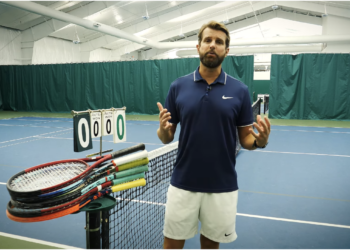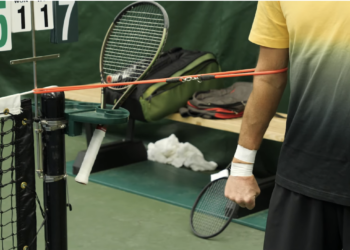Ever look down mid-match and realize your grip is peeling like a banana?
Or worse, slipping right out of your hand during your serve?
Yeah, I’ve been there and I’ve coached enough players to know it’s one of the fastest ways to lose control of your game.
The thing is, most players don’t realize how much a fresh, properly applied overgrip can impact feel, spin, and consistency. So we’re fixing that.
This guide will show you how to regrip your racquet quickly, correctly, and confidently, whether you’re dripping sweat mid-tournament or just logging weekday practice hours.
You’ll also learn how to choose the right overgrip for your hand size, sweat level, and playing style, because grip isn’t one-size-fits-all.
Let’s get a grip. Literally.
🛑 The Biggest Mistake: Confusing Overgrip vs. Replacement Grip
When folks hear “regrip,” they think it means peeling off everything and starting from scratch. Not true.
There are two layers of grip on your racquet:
- The replacement grip is the cushioned layer that comes installed from the factory. It sticks directly to the handle and is usually a bit thicker, designed for shock absorption and comfort.
- The overgrip is what you wrap on top of that. It’s thinner, cheaper, and made to be swapped out regularly.
Swapping an overgrip is quick, affordable, and makes your racquet feel brand new in under five minutes. Don’t waste money or time replacing the wrong thing.
💡 Quick Insight: Why Pros Change Overgrips Every Match (But You Shouldn’t
If you’ve watched tennis on TV, you’ve probably seen pros regripping between sets, or even during changeovers.
That’s not just for show.
Pros sweat like crazy under pressure, and they need absolute precision.
A tacky, fresh grip helps them avoid slips, stay dialed in, and feel every shot. Some even change overgrips multiple times per match.
But unless you’re hitting for hours in 95-degree heat, you don’t need that level of rotation.
For most rec players, here’s your rule of thumb:
- Play once a week? Swap your overgrip once a month.
- Playing several times a week? Once a week is your sweet spot.
Bottom line? A fresh overgrip means better control, less fatigue, and fewer blisters. It’s the cheapest upgrade in tennis and it pays off every time.
How To Regrip a Tennis Racquet Like a Pro: Step-By-Step
If you’ve ever stood courtside wondering, “Am I doing this right?” – don’t sweat it.
Regripping isn’t complicated, but it’s one of those things where a few wrong turns can ruin your feel or even mess with your swing timing.
Let’s get your racquet feeling like new.
Tools You Need
You don’t need a toolbox, just these three essentials:
- 1 Overgrip (Tourna Grip, Wilson Pro, or Yonex Super Grap are great options)
- Scissors (for trimming and cleaning up the finish)
- Finishing tape (usually included with the grip)
If you want to keep things ultra simple, grab an all-in-one grip kit – they come with everything pre-packaged, even for first-timers.
Step-By-Step: Regripping 101
1. Remove the old overgrip
Gently peel it off, don’t touch the replacement grip underneath unless it’s ripped, squishy, or lost all its cushioning.
Coach’s Note: Most players mess up here by thinking they need to strip it all. You don’t. You’re just replacing the outer layer.
2. Unwrap the new grip and find the adhesive end
The end with the sticky tab is your starting point.
That little plastic film take it off. It protects the side that touches your hand.
- Right-handed? Wrap clockwise.
- Left-handed? Wrap counterclockwise.
Yes, direction matters.
Wrapping the wrong way can cause the grip to peel mid-match and that’s a mess you don’t want to deal with.
3. Start at the butt cap
Line up the tapered edge with the bottom bevel of your racquet.
Press down firmly so it doesn’t slip while you start wrapping.
This is your foundation. If it’s loose, the whole grip will shift under pressure.
4. Pull tightly and wrap with a slight overlap (⅙ inch)
This is the part most players mess up – pull tight enough to keep tension, but not so tight that the grip stretches thin or rips.
- Overlap just enough to cover the edge of the last wrap.
- Use your thumb to anchor each turn, and your dominant hand to pull and wrap.
- Keep the wrap consistent. Wrinkles = too loose. Curling or tearing = too tight.
Player worry solved: “How tight should I pull the grip?” – Just enough to smooth it out without distortion. Practice a few times and you’ll feel the sweet spot.
5. Angle cut the end for a cleaner finish
When you get to the top, you might have extra grip left.
Grab your scissors and cut on a diagonal – this lets the edge lay flat and look pro-level.
Trust me, this one little step keeps your grip from unraveling, especially after heavy hitting.
6. Apply finishing tape
Use the strip of tape that came with your grip.
Wrap it diagonally to cover the top edge and lock your overgrip in place.
Want it extra secure? Wrap slightly up the racquet throat, not just around the circumference.
And that’s it.
If you followed along, you’ve got a fresh grip that’s tight, clean, and locked in for your next match or practice session.
🎥 Want to see exactly how it’s done – check it out in our video!
🎯 Reminder: Regripping isn’t just maintenance, it’s a performance habit. Make it part of your pre-match ritual. It resets your racquet, your rhythm, and your focus.
The 3 Types of Overgrips | Which Is Best, A Buyer’s Guide
Not all overgrips are created equal and choosing the wrong one can throw off your entire feel on the court.
Whether your hands sweat like crazy or stay bone-dry, there’s a grip out there that matches your needs.
The trick is understanding the three main types and how they perform in real conditions.
Dry Grips
Best for: Sweaty hands, hot/humid weather
Example: Tourna Grip
If you’ve ever played outdoors in the summer and felt your racquet slipping mid-forehand, this is your fix.
Dry grips have a cloth-like texture that actually performs better the more you sweat.
They’re the go-to for serious competitors, and for good reason: when your hand turns into a puddle, dry grips don’t just survive, they thrive.
Feel: Slightly abrasive but extremely secure
Durability: Wears out faster than tacky grips, but worth every penny if you sweat a lot
Tacky Grips
Best for: Players who want that “sticky” feel
Examples: Wilson Pro Overgrip, Yonex Super Grap
These grips feel like they’re hugging your palm. Great for players who want to feel “glued” to their racquet without gripping tighter.
Indoors or in cooler conditions, tacky grips give you consistent connection and better shot placement without needing a death grip on your handle.
Feel: Smooth, slightly glossy—like your racquet has grip-enhancing powers
Durability: Longer lasting than dry grips, but can get slippery if your hands sweat
All-Around Grips
Best for: Players who want one grip that adapts
Examples: Any hybrid grip that transitions from tacky to dry
These are the Swiss Army knives of the overgrip world.
They start with a bit of tack, and over time break into a more neutral, dry feel.
If your environment changes (like indoor to outdoor) or you’re still figuring out what you like, start here.
Feel: Starts sticky, becomes more cloth-like over time
Durability: Balanced, not the longest-lasting, but performs well across conditions
No matter which you choose, make sure you test a few and pay attention to how they feel under pressure.
Your grip is your link to the racquet – it’s where spin starts, where feel is transferred, and where matches are won or lost. Get it right, and every shot just feels better.
Source -> ADV Tennis
Real Player Questions You’re Probably Asking Right Now
“Can I reuse an overgrip?”
Technically? Yes. Practically? No.
Once an overgrip loses its tack or absorbency, it’s just dead weight. It might look fine, but it’s not doing your hand any favors. Reusing can also lead to:
- More blisters
- Slippery feel
- Lack of control on key points
If you’re serious about improving, fresh grips are the way to go.
And honestly, they’re one of the cheapest upgrades in tennis. Stock up in bulk and never look back.
“Should I switch grips seasonally?”
Absolutely. This is a pro-level move most rec players don’t take advantage of.
Here’s the switch-up strategy:
- Summer / outdoor / humid play? Go with a dry grip (like Tourna Grip). It gets grippier as you sweat.
- Winter / indoor / dry air? You’ll love a tacky grip (like Wilson Pro) for that sticky, connected feel.
Your hands don’t sweat the same year-round, so why should your grip?
“Do I need to change the whole grip every time?”
Nope. You only need to swap the entire replacement grip if it’s:
- Torn
- Compressed beyond repair
- Lost all its cushioning
Otherwise, you’re just changing the overgrip – the top layer that takes the beating.
Pro Tips From PlayYourCourt Coaches
Regripping your racquet is a mindset.
At PlayYourCourt, we work with thousands of players who are chasing progress, and the ones who improve fastest treat their gear like part of their routine.
Below are a few pro-level tips from our coaching team that can turn your regripping into a ritual and a weapon.
Use Regripping as a Ritual Before Matches
There’s something powerful about the process.
Unwrapping the old grip, smoothing on the new one, feeling the tension of each wrap, it’s more than prep. It’s a reset.
Before a match, a fresh grip tells your brain: Let’s go. I’m ready to compete.
I used to regrip before every tournament match, not because I had to, but because it mentally put me in the zone. It’s one of those little habits that can sharpen your edge without ever swinging a racquet.
Cut the Final Edge at an Angle – Prevents Peeling
It might seem like a cosmetic detail, but cutting the grip at a 45-degree angle does two important things:
- It makes your grip lay flatter and stick better.
- It prevents the dreaded flap that peels mid-match and distracts you every time you go to serve.
This tiny adjustment makes your wrap look and feel pro-level and it takes all of three seconds to do.
Buy Grips in Bulk – Saves Money & Sweat-Induced Stress
If you’re playing more than once a week, you should never be caught without a spare grip.
Stocking up in bulk:
- Saves money over time (multi-packs cost way less per grip)
- Ensures you never step on court with a dead grip again
- Lets you change more frequently, before slippage affects performance
🧠 Coach Nate’s pro tip: Keep a few grips in your bag, your car, and even your sock drawer. A fresh grip is like new tires on a race car – don’t wait until the tread is gone.
Whether you’re gearing up for a tournament or just logging hours at your local court, these little rituals and tweaks make a big difference.
PlayYourCourt is all about helping you improve faster and sometimes, it’s not about more drills or lessons. It’s about building the habits that make winning automatic.
A Small Fix That Delivers Big Wins
Swapping your grip might seem like one of those minor maintenance tasks you can push off, but in reality, it’s one of the fastest, easiest upgrades you can make to your game. Why?
Because better grip equals better performance, period.
- Better control on every swing
- Fewer blisters on those grind-it-out days
- Less racquet slip, especially when your palms are sweaty and the match is tight
It’s about confidence. When your racquet feels locked in, you swing freer, play looser, and hit with more intent. That’s the stuff that moves the needle.
But here’s the thing: if you seriously want to improve, a fresh grip is just the beginning.
PlayYourCourt has evolved into a full-blown game improvement platform, your all-in-one tennis ecosystem.
So don’t stop at regripping your racquet. Regrip your entire approach to tennis.
👉 Explore our membership and unlock faster progress, smarter training, and a whole new way to level up.



